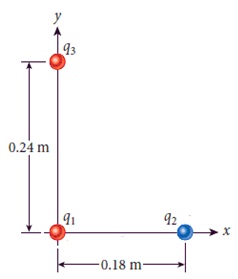Assignment:
Part 1
1) How many electrons do 6.94 kg of water contain?
2) Two identically charged particles separated by a distance of 7.8 m repel each other with a force of 9 N. What is the magnitude of the charges?
3) In solid sodium chloride (table salt), chloride ions have one more electron than they have protons, and sodium ions have one more proton than they have electrons. These ions are separated by about 0.28 nm. Calculate the electrostatic force between a sodium ion and a chloride ion.
4) In gaseous sodium chloride, chloride ions have one more electron than they have protons, and sodium ions have one more proton than they have electrons. These ions are separated by about 0.24 nm. Suppose a free electron is located 0.86 nm above the midpoint of the sodium chloride molecule. What are the magnitude and the direction of the electrostatic force the molecule exerts on it? (Assume the chloride ion lies on the +x-axis and the sodium ion lies on the -x-axis, with the origin as the midpoint between the two ions. The free electron lies on the +y-axis.)
5) Identical point charges Q are placed at each of the four corners of a rectangle measuring 8.0 m by 9.0 m. If Q = 26 µC, what is the magnitude of the electrostatic force on any one of the charges?
6) Charge q1 = 1.1 10-8 C is placed at the origin. Charges q2 = -1.3 10-8 C and q3 = 2.6 10-8 C are placed at points (0.18 m, 0 m) and (0 m, 0.24 m), respectively, as shown in the figure. Determine the net electrostatic force (magnitude and direction) on charge q3.

7) A small ball with a mass of 10 g and a charge of -0.2 µC is suspended from the ceiling by a string. The ball hangs at a distance of 5.0 cm above an insulating floor. If a second small ball with a mass of 60 g and a charge of 0.4 µC is rolled directly beneath the first ball, will the second ball leave the floor?
8) Four point charges, q, are fixed to the four corners of a square that is 15.0 cm on a side. An electron is suspended above a point at which its weight is balanced by the electrostatic force due to the four point charges, at a distance of 13 nm above the center of the square. (The square is horizontally flat, and the electron is suspended 13 nm vertically above the center of the square.) What is the magnitude of each fixed charge in coulombs? What is the magnitude of each fixed charge as a multiple of the electron's charge?
Part 2
1) A +1.5-nC point charge is placed at one corner of a square (1.5 m on a side), and a -3.0-nC charge is placed on the corner diagonally opposite. What is the magnitude of the electric field at either of the other two corners?
2) Consider an electric dipole on the x-axis and centered at the origin. At a distance h along the positive x-axis, the magnitude of electric field due to the electric dipole is given by k(2qd)/h3. Find a distance perpendicular to the x-axis and measured from the origin at which the magnitude of the electric field stays the same. (Use the following as necessary: h and d.)
3) A charge per unit length +λ is uniformly distributed along the positive y-axis from y = 0 to y = +a. A charge per unit length -λ is uniformly distributed along the negative y-axis from y = 0 to y = -a. Write an expression for the electric field at a point on the x-axis a distance x from the origin. (Use the following as necessary: k, λ, x, and a.)
4) An electron is observed traveling at a speed of 1.67 107 m/s parallel to an electric field of magnitude 11,360 N/C. How far will the electron travel before coming to a stop? (The mass of electron is 9.109 10-31 kg, and the charge on the electron is 1.602 10-19 C. The electron is moving in the direction opposite to the electric field.)
5) A -7-nC point charge is located at the center of a conducting spherical shell. The shell has an inner radius of 2 m, an outer radius of 4 m, and a charge of +8 nC. (Let the radially outward direction be positive.)
(a) What is the electric field at r = 1 m?
(b) What is the electric field at r = 3 m?
(c) What is the electric field at r = 7 m?
(d) What is the surface charge distribution, σ, on the outside surface of the shell?